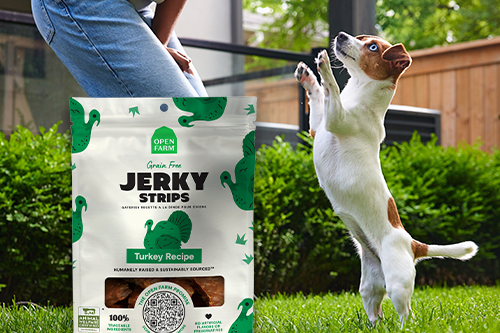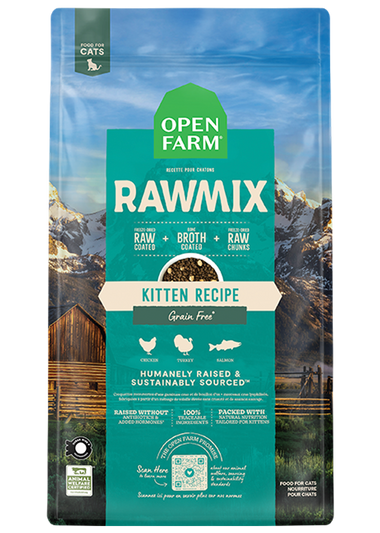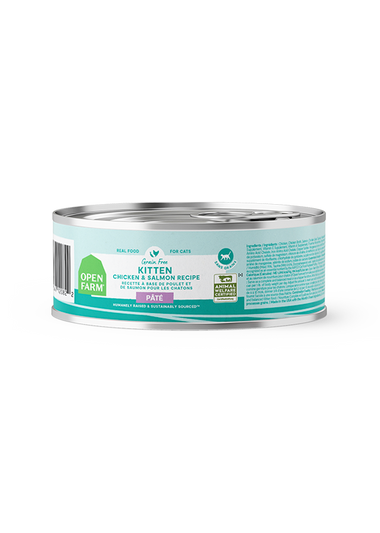Choosing between wet food or dry food for kittens is one of many key decisions you’ll make as a pet parent. Both provide essential nutrients, but the value each provides to your kitten depends on its preferences and dietary needs. Understanding the differences between dry and wet food for kittens can help you make an informed choice. This helps your kitten get the best nutrition, so it can grow strong and thrive!
Should Kittens Eat Wet or Dry Food?
Your kitten will require a diet that keeps up with its lightning-fast growth and energy needs. Both wet and dry food have a place in your cat’s diet as each offer unique advantages. Since your kitten’s nutritional requirements change as its grows, you’ll need to choose the right food at each stage of development. This means providing a balance, which could involve wet or dry food or a combination of the two.
Kitten Wet Food: Pros and Cons
Wet food is a popular choice for kittens because of its soft texture and high moisture content but there are both advantages and disadvantages:
Pros:
- Higher moisture content can help support hydration, especially if your kitty doesn’t drink enough water.
- Softer texture makes it easier for young kittens to eat, particularly when going from milk to solid food.
- Stronger aroma and taste may tantalize even the pickiest eaters.
Cons:
- Requires refrigeration after opening.
- Shorter shelf life compared to dry kibble once opened.
Dry Food for Kittens
Dry food is another option that provides key nutrients and can be more convenient for pet parents. Have a look at the benefits and drawbacks:
Pros:
- Convenient and easy to store without refrigeration.
- Can help promote healthy chewing behaviour.
- Longer shelf life and typically more cost-effective than wet food.
Cons:
- Lower moisture content compared to wet food, so kittens may need to drink more water.
- Some kittens may find it harder to chew, especially at a very young age.
- Less aromatic and flavourful than wet food, which may be less appealing to some kittens.
Should Kittens Eat Dry or Wet Food Exclusively?
You might wonder whether your kitten should eat only one type of food. This depends on its individual preferences, lifestyle, and health considerations. Although your kitten can thrive on a wet-only or dry-only diet, combining both may provide the best balance.
Dry and Wet Food for Kittens: Can They Have Both?
Giving your cat both wet and dry food can help provide a variety of textures and nutritional benefits. A mixed feeding approach may support hydration while also allowing kittens to enjoy the benefits of chewing dry kibble.
How to Introduce Both Wet and Dry Food
Follow the steps below if you want to feed your kitten a combination of wet and dry food.
- Start with wet food: Younger kittens, especially those under 8 weeks old, often prefer wet food since it is usually easier to chew and digest.
- Introduce dry food gradually: You can start mixing small amounts of dry kibble with wet food at around 8-12 weeks. It’s always smart to check in with your vet before making dietary changes.
- Adjust the ratio: You can experiment with different proportions of wet and dry food over time to find out what works best for your kitten.
- Monitor hydration: If your kitten consumes more dry food, make sure it gets plenty of water.
- Observe your kitten’s preferences: Your kitten is unique, so its food preference will vary compared to other young cats. Adjust its diet based on what it enjoys and also on what supports their growth.
How Much Should You Feed Your Kitten?
Kittens require frequent meals to support their rapid growth. General feeding guidelines include:
- Up to 8 weeks old: Primarily consume wet food or a soft mixture of wet and dry food.
- 8-12 weeks old: Feed small, frequent meals (about 4 times a day).
- 3-6 months old: Reduce feeding to 3 meals a day.
- 6+ months old: Consider transitioning to 2 meals per day with a balanced mix of wet and dry food.
Final Thoughts
Deciding between wet food or dry food for a kitten depends on its individual needs, preferences, and stage of development. Wet food provides needed hydration and a soft texture that many kittens crave. Dry food is convenient and helps promote healthy chewing behaviour. A combination of both may give your kitten’s diet the balance it needs for best growth and wellbeing. As a proudly Canadian-founded company, Open Farm is committed to offering ethically sourced, high-quality nutrition for pets at every stage of life. Whether you’re starting with a playful kitten or supporting your cat into adulthood, we’re here to help you find the best nutrition for your pet.
This article is meant only as an example of what might work well for your pet, please reach out to our Pet Parent Experience Team if you have any questions about your pet’s own unique circumstances! To ensure these products are a good fit for your furry friend, we also recommend consulting your vet about any new diet, or environment changes, especially if there is a medical concern. They should be able to help as you and your vet know your pet’s medical history best!








































 Sign In
Sign In
 Create Account
Create Account












